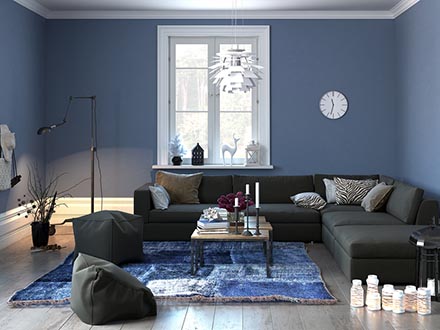The Psychology of Colour Therapy in Interior Design

Have you ever wondered why you feel more relaxed when you're in a natural setting? Studies have revealed that the colours in our environment have a direct impact on our mental health. For example, green tones are known to have a balancing and harmonising effect on our state-of-mind.
The positive effects of colour on mental health relate to the practice of Colour Therapy. Colour Therapy uses colour as a tool to enhance health. This form of therapy identifies the seven spectrum colours orange, blue, violet, green, red, yellow and indigo as each having a different type of energy which correspond to one of the seven energy centres or chakras of the body. With Colour Therapy, for good health and well-being to be achieved there needs to be a balance between the colours.
Why is Colour Therapy so important?
A study undertaken by paint specialist Dulux uncovered that colour not only impacts on an individuals mood, it also has the ability to create a healing environment. (https://www.buildingbetterhealthcare.co.uk/technical/article_page/The_psychology_of_colour/95179) While the study revealed the positive affects of colour for healing in a medical environment, the principles of Colour Therapy can also be applied to other environments, such as your home or business interior, to assist with enhancing mental health and relieving stress.
How colour therapy is incorporated within interior design
To effectively incorporate Colour Therapy in Interior Design involves the use of both natural and synthetic light, as well as adding colour through other forms such as painting, wallpaper and art. While natural light is preferred within Colour Therapy over synthetic light, because sunlight is a combination of all the energy wavelengths in the colour spectrum, synthetic light is a good alternative when natural light is unavailable.
The seven different energy forms of the colours in the spectrum
For a better understanding of Colour Therapy its important to grasp the seven different energy forms that make up the full colour spectrum which are identified below:
Violet
Violet has a calming and purifying energy which is believed to also heighten awareness.
Indigo
Indigo is identified as having an intuitive energy form that sedates the body and mind.
Orange
Oranges energy is believed to warming and energising, as well as stimulating creativity.
Blue
Blue as an energy form is defined as being calming, healing and relaxing.
Green
As previously identified earlier in this article the energy form attributed to the colour green is balancing and harmonising. Green energy is also believed to encourage a deeper understanding and tolerance.
Red
Red in Colour Therapy has a stimulating and emotionally exciting energy.
Yellow
Yellow as an energy form heightens mental activity and alertness, along with promoting confidence.
When Colour Therapy is used for interior design applications the choice of colours incorporated within an environment, whether domestic or commercial, are dependent on the energy forms that each client would like to experience. For colour balance to be achieved, different colours can be applied to different areas or rooms in an environment. An example of this would be painting and decorating the bedrooms in a house with shades of green and blue to promote relaxation and harmony.
If you're interested in incorporating Colour Therapy within the interior design concept of your home or business contact the experts at Jarvis Interiors today. Jarvis Interiors specialise in the use of colour, sound and light therapy to enhance environments and help improve their clients lives, health and well-being. Arrange a consultation with the team to discuss how Colour Therapy can be applied to customise your environment and follow Jarvis Interiors blogs for further interior design inspiration for your domestic or commercial setting.
